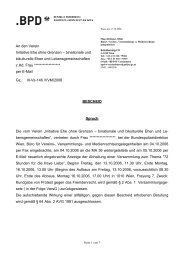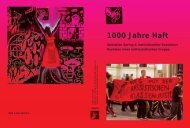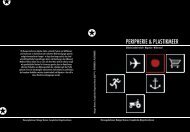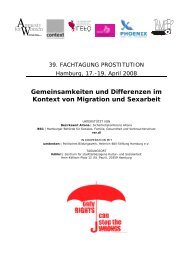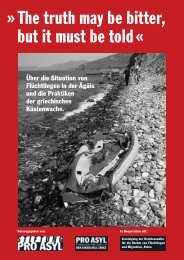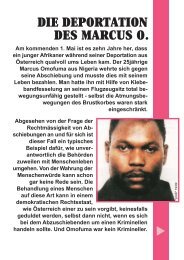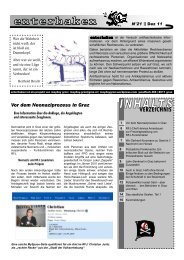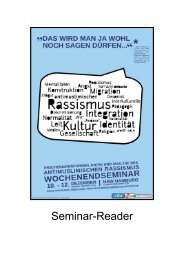Turin's CIE - International University College of Turin
Turin's CIE - International University College of Turin
Turin's CIE - International University College of Turin
You also want an ePaper? Increase the reach of your titles
YUMPU automatically turns print PDFs into web optimized ePapers that Google loves.
III.<br />
PRISON AND <strong>CIE</strong><br />
1. IDENTIFICATION PROCEDURES FOR PRISONERS AND ACCESS TO<br />
LEGAL INFORMATION<br />
A significant proportion <strong>of</strong> the detainees who were interviewed had been detained in jail and<br />
later transferred to <strong>CIE</strong> after finishing their jail sentences. The ex-prisoners who participated in<br />
the study had been released from prison in order to face a new deprivation <strong>of</strong> liberty that nonimmigrant<br />
prisoners do not face. There are many cases where detainees were completely<br />
unaware that after jail they would be taken to <strong>CIE</strong>. These detainees thought they had repaid<br />
their debt to society and that they would be finally free: "After five years <strong>of</strong> prison they told me to<br />
be prepared, because I was going to be released, but I was taken to Questura [...] and after three<br />
hours they explained to me that I had to be identified and that they were going to take me in <strong>CIE</strong><br />
[...] I didn't know what <strong>CIE</strong> was" (Interview 25). <strong>CIE</strong> is not a prison, or at least it should not be.<br />
Yet, the evidence described in the following section reveals that the reality <strong>of</strong> <strong>CIE</strong> is no different<br />
from prison and generally <strong>CIE</strong> is even worse. In <strong>CIE</strong> the limitation to personal freedom is<br />
coupled with more severe living conditions and isolation from the outside world, which is<br />
exacerbated by the lack <strong>of</strong> activities or education opportunities.<br />
In Italy there is no specific act <strong>of</strong> parliament to address the issue <strong>of</strong> whether a person in criminal<br />
custody should be identified and have any barriers to expulsion removed while they are still in<br />
criminal custody. However, on 30 July 2007 the Direttiva Interministeriale del Ministero<br />
dell’Interno e del Ministero della Giustizia (Inter-ministerial Directive by the Ministry <strong>of</strong> the<br />
Interior and the Ministry <strong>of</strong> Justice) 50 was signed by former Minister <strong>of</strong> the Interior Giuliano<br />
Amato and former Minister <strong>of</strong> Justice Clemente Mastella, in order to establish an alternative<br />
measure whereby identification and deportation would occur without passing through centres<br />
for temporary detention (CPTs) 51 . The procedure suggested a strict collaboration between<br />
prison authorities and Questura in order to identify migrants during their detention in prison.<br />
After migrants were identified, the Ministerial Directive aimed to transfer them to another<br />
prison that was as close as possible to the place <strong>of</strong> deportation so that they would be repatriated<br />
upon release. Furthermore, the Ministerial Directive provided that authorities, upon Questura’s<br />
request, should concentrate all foreigners <strong>of</strong> the same nationality in prisons that are located<br />
near their diplomatic representatives in order to facilitate collaboration. This kind <strong>of</strong> directive is<br />
not strictly obligatory because it is a ministerial proposal. However, the notion behind such<br />
proposals is that the Ministry is expressing guidance on an issue that will then be made into a<br />
legal rule. Nevertheless, this Ministerial Directive does not appear to be applied in <strong>Turin</strong> and<br />
<strong>of</strong>ten nothing is done to try to identify a person during their prison sentence.<br />
According to Direttiva del Ministero della Giustizia 30 luglio 2007, Questura should be promptly<br />
informed when there is a final judgement that imprisons an irregular migrant. This would make<br />
it possible to immediately start the identification procedure. It is important to remember that<br />
detention in <strong>CIE</strong> should not be the rule but rather only the least preferred remedy 52 . If there is<br />
any chance to avoid a person’s detention in <strong>CIE</strong>, then this should be taken into account. If<br />
identification occurred in prison it could avoid subsequent periods <strong>of</strong> <strong>CIE</strong> detention, or at least<br />
prior identification could reduce the necessary period <strong>of</strong> administrative detention:<br />
50 Direttiva Interministeriale del Ministero dell’Interno e del Ministero della Giustizia firmata il 30 luglio 2007.<br />
Inter-ministerial Directive by the Ministry <strong>of</strong> the Interior and the Ministry <strong>of</strong> Justice, signed 30 July 2007.<br />
51 CPT is the old name for the Italian identification centres that existed before the <strong>CIE</strong> system.<br />
52 Directive 2008/115/EC, Article 15(1).<br />
31 | P a g e




